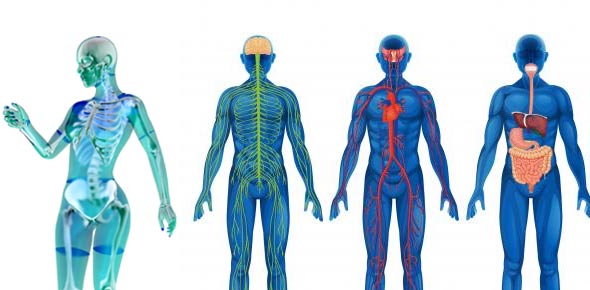9.Introduction To Neuroanatomy & Spinal Cord-aĞaÇ
-
The brain in the skull and the spinal cord in the vertebral column are surrounded by three protective membranes, or meninges: the dura mater, the arachnoid mater, and the pia mater.
-
True
-
False
-
About This Quiz
8 SORUDAN 5 SORU VEYA DAHA AZINI BİLDİYSEN BİR DAHA OKU!

Quiz Preview
- 2.
Forebrain is made by telencephalon and diencephalon.
-
True
-
False
Correct Answer
A. TrueExplanation
The forebrain is indeed made up of two main parts: the telencephalon and the diencephalon. The telencephalon consists of the cerebral cortex, which is responsible for higher cognitive functions, and the basal ganglia, which are involved in movement control. The diencephalon includes structures like the thalamus, which relays sensory information to the cortex, and the hypothalamus, which regulates various bodily functions. Therefore, it is correct to say that the forebrain is composed of the telencephalon and the diencephalon.Rate this question:
-
- 3.
Unipolar neurons are found in some ganglia of the autonomic nervous system.
-
True
-
False
Correct Answer
A. TrueExplanation
Unipolar neurons are indeed found in some ganglia of the autonomic nervous system. Unipolar neurons have a single process that extends from the cell body and acts as both an axon and a dendrite. These neurons are commonly found in sensory ganglia, where they transmit sensory information from the peripheral nervous system to the central nervous system. In the autonomic nervous system, unipolar neurons can be found in certain ganglia that control involuntary bodily functions such as heart rate, digestion, and respiration. Therefore, the statement "Unipolar neurons are found in some ganglia of the autonomic nervous system" is true.Rate this question:
-
- 4.
Neurons in the dorsal root ganglia are pseudo-unipolar type.
-
True
-
False
Correct Answer
A. TrueExplanation
Neurons in the dorsal root ganglia are pseudo-unipolar type because they have a single process that divides into two branches, one going towards the periphery and the other towards the central nervous system. This unique structure allows them to transmit sensory information from the peripheral nerves to the spinal cord efficiently.Rate this question:
-
- 5.
CN XI is the glossopharyngeal nerve.
-
True
-
False
Correct Answer
A. FalseExplanation
The statement is false. CN XI refers to the accessory nerve, not the glossopharyngeal nerve.Rate this question:
-
- 6.
“Peripheral nerves” is a collective term for the cranial and spinal nerves.
-
True
-
False
Correct Answer
A. TrueExplanation
The statement is true because peripheral nerves refer to the nerves that extend from the brain and spinal cord to various parts of the body. This includes both the cranial nerves, which emerge from the brain, and the spinal nerves, which emerge from the spinal cord. Therefore, "peripheral nerves" is indeed a collective term for both the cranial and spinal nerves.Rate this question:
-
- 7.
Somatic efferent fibers (Somatic motor- Somatomotor) fibers go to the smooth muscles.
-
True
-
False
Correct Answer
A. FalseExplanation
The statement is false because somatic efferent fibers do not go to smooth muscles. Somatic efferent fibers are responsible for controlling skeletal muscles, not smooth muscles. Smooth muscles are controlled by autonomic efferent fibers.Rate this question:
-
- 8.
General visceral afferent (GVA) fibers carry special sensory information unique to the organs
-
True
-
False
Correct Answer
A. FalseExplanation
GVA fibers do not carry special sensory information unique to the organs. Instead, they carry general sensory information from the internal organs such as pain, stretch, and temperature. Therefore, the statement is false.Rate this question:
-
Quiz Review Timeline (Updated): Mar 21, 2023 +
Our quizzes are rigorously reviewed, monitored and continuously updated by our expert board to maintain accuracy, relevance, and timeliness.
-
Current Version
-
Mar 21, 2023Quiz Edited by
ProProfs Editorial Team -
May 06, 2015Quiz Created by
Ykaan2000
NDT 101: Neuroanatomy And Physiology Quiz
Neuroanatomy is the study of the structure and organization of the nervous system. Are you an advanced reader of neuroanatomy and physiology? Take this super complex quiz and know...
Questions:
69 |
Attempts:
335 |
Last updated:
Jan 20, 2023
|
Compre Exam 4 Neuroanatomy, Blood And Endocrine Physiology
This comprehensive exam covers key topics in Neuroanatomy, Blood Physiology, and Endocrine Physiology, focusing on structures of the CNS, PNS, and embryological development. It...
Questions:
50 |
Attempts:
159 |
Last updated:
Sep 07, 2023
|
SCID 251 - Lab Exam-1 Tutorial
SCID 251 - Lab exam-1 tutorial is designed to test knowledge of neuroanatomy through imaging techniques, focusing on structures like the ant medullary velum and calcified pineal...
Questions:
29 |
Attempts:
37 |
Last updated:
Apr 19, 2023
|
Neuroanatomy And Spinal Cord Trivia Quiz!
Dive into the complexities of the nervous system with our Neuroanatomy and Spinal Cord Trivia Quiz! Test your knowledge on neurites, neuron structures, and the divisions of the...
Questions:
8 |
Attempts:
577 |
Last updated:
Mar 22, 2023
|
Otterbein/Grant CRNA A&P Midterm Neuro Review
The Otterbein\/Grant CRNA A&P Midterm Neuro Review assesses knowledge of neuroanatomy and physiology, focusing on brain structures, CSF flow, and white matter characteristics....
Questions:
48 |
Attempts:
179 |
Last updated:
Mar 20, 2023
|
Neuroanatomy Organization Of Nervous Systems Quiz
Do you want to test your nervous system knowledge? Let's play this neuroanatomy practice quiz and prove yourself!
Questions:
39 |
Attempts:
1548 |
Last updated:
Mar 21, 2023
|
 Back to top
Back to top








